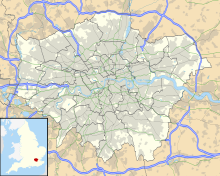Hornchurch Airfield
|
RAF Hornchurch |
|||||||||||
|---|---|---|---|---|---|---|---|---|---|---|---|

Station Crest
|
|||||||||||
| Summary | |||||||||||
| Airport type | Military | ||||||||||
| Owner | Air Ministry | ||||||||||
| Operator |
Royal Flying Corps Royal Air Force |
||||||||||
| Location | Hornchurch | ||||||||||
| Built | 1915 and 1928 | ||||||||||
| In use | 3 October 1915 – 31 December 1919, (As Sutton's Farm), 1 April 1928 – 1 July 1962, (As RAF Hornchurch) |
||||||||||
| Elevation AMSL | 36 ft / 11 m | ||||||||||
| Coordinates | 51°32′19″N 000°12′17″E / 51.53861°N 0.20472°ECoordinates: 51°32′19″N 000°12′17″E / 51.53861°N 0.20472°E | ||||||||||
| Map | |||||||||||
| Location in London | |||||||||||
| Runways | |||||||||||
|
|||||||||||
Royal Air Force Station Hornchurch or RAF Hornchurch was an airfield in the parish of Hornchurch, Essex (now the London Borough of Havering in Greater London), located to the southeast of Romford. The airfield was known as Sutton's Farm during the First World War, when it occupied 90 acres (360,000 m2) of the farm of the same name. It was used for the protection of London, being 14 miles (22.5 km) east north-east of Charing Cross. Although the airfield closed shortly after the end of the war, the land was requisitioned in 1923 because of the expansion of the Royal Air Force and it re-opened as a much larger fighter station in 1928. The airfield was ideally located in bomb alley to cover both London and the Thames corridor from German air attacks. It was a key air force installation between both wars and into the jet age, closing in 1962.
In 1915 the London Air Defence Area (LADA) was established and a number of airfields were constructed around London with the specific aim of defending the capital from the growing threat from enemy airships. Sutton's Farm, along with its neighbour Hainault Farm (just east of what became the Second World War airfield of Fairlop), 8 miles (12.9 km) to the north-east, were selected due to their location covering the eastern approaches to London. They were designated Landing Grounds Nos. II and III respectively and joined the existing airfields of North Weald, Rochford and Joyce Green. Suttons Farm airfield became operational on 3 October 1915, initially with two BE2c aircraft. As the number of aircraft increased at the airfields around London, it was decided to organise them into 39 Home Defence Squadron, which was formed in April 1916, under the command of Major (later Brigadier-General) Thomas Higgins. As the enemy threat moved from airships to aircraft, so better aircraft were introduced to counter them. The BE12, Sopwith 1½ Strutter, Sopwith Pup, FE2, Bristol Fighter, SE5a and Sopwith Camel all operated from Sutton's Farm at some stage, some with more success than others. 39 Squadron moved to North Weald in September 1917 and was replaced by 78 Squadron, under the command of Major Cuthbert Rowden, a 20 year old veteran of the air war in France and subsequent winner of the Military Cross. 78 Squadron was later joined by 189 Night Fighter Training Squadron with Sopwith Pups and Camels.
...
Wikipedia

